Cupbearer Was Privy To Conversations And Political Secrets Hidden Behind Closed Doors
A. Sutherland - AncientPages.com - The role of the cupbearer goes back many thousands of years, and many prominent figures held it.
The cupbearer was a trusted person at the royal courts and in the nobles' and princes' households. His duty was to supervise, pour, and serve the drinks at the royal table.
 Nehemiah served as the king's cupbearer (Nehemiah 1:11), which gave him countless possibilities to speak to the king and request favors from him. Image source
Nehemiah served as the king's cupbearer (Nehemiah 1:11), which gave him countless possibilities to speak to the king and request favors from him. Image source
The chosen cupbearer was usually a high-ranked and noble person of the royal court. Usually, he was also influential, wealthy, and the ruler trusted him, often showing gratitude.
He was with the ruler at all times, and his primary duty was to taste the wine served to the king as a precaution against poisoning. The king could rely on his loyalty and trust him.
In old times, monarchs were paranoid about attempted assassinations, but not without reason. Due to the constant fear of conspiracies and intrigue, the king's cupbearer must be completely reliable. As poisoning was very often a way to get rid of a king or another important figure, the cupbearer's most serious responsibility was to protect his master, family members, and guests at the table.
Secret Conversations Behind Closed Doors
He had to make sure that no one had tampered with drinks and food. The cupbearer would also pour wine or other drinks to honored guests present at the table. It would make him privy to many conversations taking place at the table and political secrets that were always hidden behind closed doors.
In many cases, the threat of poisoning was often real. The cupbearer's high-risk job was not only vital but also dangerous and full of responsibility because he was also a security officer to protect him against assassination.
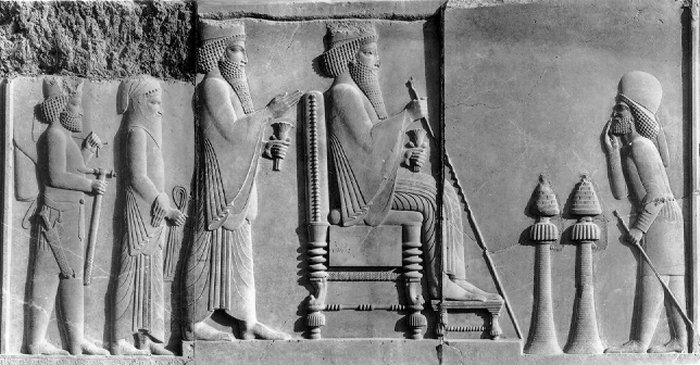 Bas-Relief From Persepolis, Ancient Persia). It shows Darius I, the Great, sitting on the throne, and he is followed by his son, Xerxes, the Crown Prince. Nehemiah - the Chief Cupbearer, is standing behind Xerxes. Credit: Public Domain
Bas-Relief From Persepolis, Ancient Persia). It shows Darius I, the Great, sitting on the throne, and he is followed by his son, Xerxes, the Crown Prince. Nehemiah - the Chief Cupbearer, is standing behind Xerxes. Credit: Public Domain
He daily placed his own life at risk, which made his profession extremely dangerous.
The Cupbearer Was A Trusted Advisor
The cupbearer was the king's trusted advisor and the one who was expected to give honest advice behind closed doors. Being almost always in the king's presence, the cupbearer listened to many private and often secret information. Therefore, he was required to be trustworthy and able to keep the confidence.
Having his master's affection and trust, the cupbearer could change his career path by getting a position with significant influence.
There were many prominent, wealthy, and trusted cupbearers in Sumer, Egypt, where foreigners held the position as cupbearers, Assyria, Canaan, Persia, Poland, Sweden, and other royal courts.
In Mesopotamia, the job of a cupbearer was highly respected. Kings had assigned cupbearers, who were trusty members of the royal court responsible for overseeing all the dining activities. Cupbearers' work was not only limited to kings but also government workers.
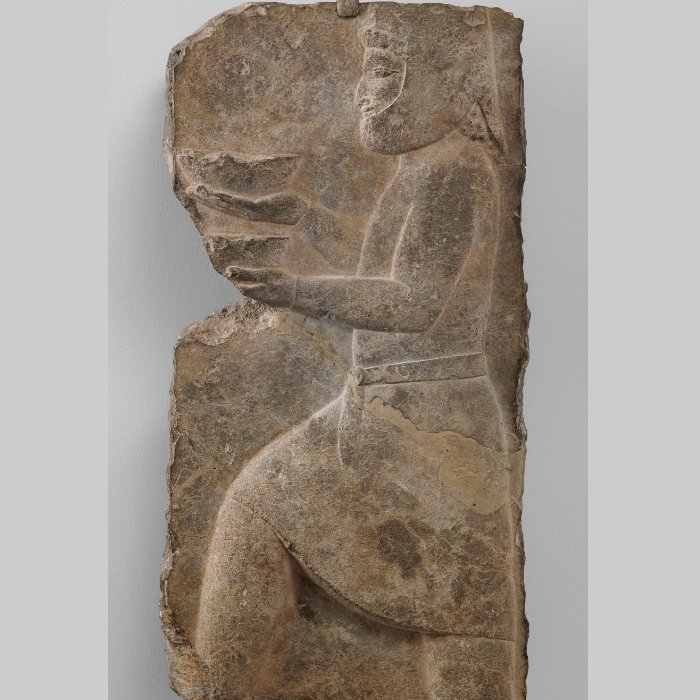 Persian, Achaemenid, Persepolis, Iran, 486–465 B.C., Cupbearer, relief from the Palace of Xerxes I. source
Persian, Achaemenid, Persepolis, Iran, 486–465 B.C., Cupbearer, relief from the Palace of Xerxes I. source
One of the most famous personalities of the ancient world was Sargon of Akkad, who was the cupbearer for Ur-Zababa of Kish. As many of us probably know, he would later take the throne as the first emperor of the Akkadian Empire in 2334 BC, and his great empire flourished about two centuries before it finally ended around 2,100 B.C.
Another cupbearer was Nehemiah, a high official in the Persian court of King Artaxerxes I at Susa's capital city in what is now modern Iran.
Nehemiah wanted so much to return to Jerusalem to rebuild Jerusalem's walls. So e did, but before it happened, he served as the king's cupbearer (Nehemiah 1:11), which gave him countless possibilities to speak to the king and request favors from him.
Herodotus described the royal cupbearer's office in Persia as a great honor "of very particular distinction."
Also, an Athenian historian, philosopher, and soldier, Xenophon (c.430 BC – 354 BC), described a cupbearer's duties in the royal court of the Medes. According to his description, the cupbearer was "handsome" and had the role of presenting certain persons to the king and keeping others out. He poured and served the wine to the king with great skill, tasting it first to guard against poisoning.
Written by – A. Sutherland - AncientPages.com Senior Staff Writer
Updated on January 31, 2024
Copyright © AncientPages.com All rights reserved. This material may not be published, broadcast, rewritten or redistributed in whole or part without the express written permission of AncientPages.com
Expand for referencesReferences:
O F Walton, The King's Cup-Bearer
Princeton University Art Museum
Herodotus, The Histories, John M. Marincola, et al.
More From Ancient Pages
-
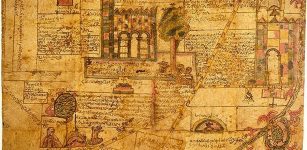 What Does The Mexican Codex Map Represent?
Ancient History Facts | May 21, 2018
What Does The Mexican Codex Map Represent?
Ancient History Facts | May 21, 2018 -
 Ördög – Shapeshifting Demon Who Controls The Evil And Dark Forces In The World
Featured Stories | Oct 23, 2019
Ördög – Shapeshifting Demon Who Controls The Evil And Dark Forces In The World
Featured Stories | Oct 23, 2019 -
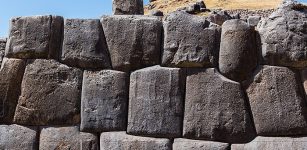 30,000-Year-Old Hidden Writing Found At Sacsayhuamán Temple Could Re-Write History
Civilizations | Jun 24, 2014
30,000-Year-Old Hidden Writing Found At Sacsayhuamán Temple Could Re-Write History
Civilizations | Jun 24, 2014 -
 The Hobbit – An Ancient Hominin Species May Still Be Living In The Forests Of Flores Island – Anthropologist Says
Archaeology | Apr 20, 2022
The Hobbit – An Ancient Hominin Species May Still Be Living In The Forests Of Flores Island – Anthropologist Says
Archaeology | Apr 20, 2022 -
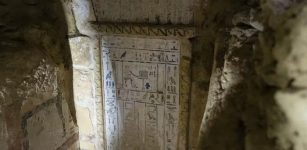 Archaeologists Have Discovered A Mummy Wrapped In Gold – Here’s What It Tells Us About Ancient Egyptian Beliefs
Featured Stories | Feb 7, 2023
Archaeologists Have Discovered A Mummy Wrapped In Gold – Here’s What It Tells Us About Ancient Egyptian Beliefs
Featured Stories | Feb 7, 2023 -
 Life Of Earliest Modern Humans In Europe Revealed By Excavations Conducted In Romania
Archaeology | Aug 24, 2022
Life Of Earliest Modern Humans In Europe Revealed By Excavations Conducted In Romania
Archaeology | Aug 24, 2022 -
 Ptolemaic Granite Sarcophagus Found In Alexandria, Egypt
Archaeology | Jul 6, 2018
Ptolemaic Granite Sarcophagus Found In Alexandria, Egypt
Archaeology | Jul 6, 2018 -
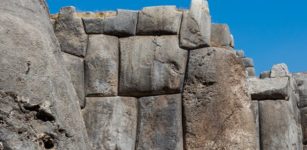 Mysterious Killke Culture Of Peru: Did They Construct Sacsayhuaman?
Civilizations | Mar 14, 2019
Mysterious Killke Culture Of Peru: Did They Construct Sacsayhuaman?
Civilizations | Mar 14, 2019 -
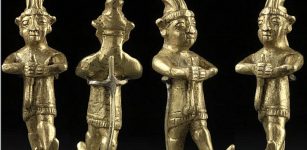 Golden Figurine From Yozgat Depicts Unknown Hittite God
Artifacts | May 11, 2016
Golden Figurine From Yozgat Depicts Unknown Hittite God
Artifacts | May 11, 2016 -
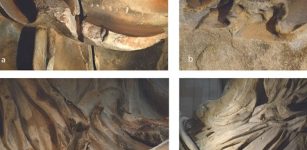 True Colors Of The Parthenon Sculptures Revealed In New Study
Artifacts | Oct 12, 2023
True Colors Of The Parthenon Sculptures Revealed In New Study
Artifacts | Oct 12, 2023 -
 Medieval Manor Of Court De Wyck – Re-Discovered
Archaeology | Oct 10, 2023
Medieval Manor Of Court De Wyck – Re-Discovered
Archaeology | Oct 10, 2023 -
 2,500-Year-Old Phoenician Shipwreck Being Rescued By Archaeologists
Archaeology | Jul 4, 2023
2,500-Year-Old Phoenician Shipwreck Being Rescued By Archaeologists
Archaeology | Jul 4, 2023 -
 Mischievous Irish Pooka, Shapeshifter And Prankster Has Its Counterparts
Featured Stories | Mar 15, 2018
Mischievous Irish Pooka, Shapeshifter And Prankster Has Its Counterparts
Featured Stories | Mar 15, 2018 -
 Bizarre Mummies And Skeletons That May Offer Evidence Strange Mythical Creatures Did Exist
Featured Stories | Nov 16, 2018
Bizarre Mummies And Skeletons That May Offer Evidence Strange Mythical Creatures Did Exist
Featured Stories | Nov 16, 2018 -
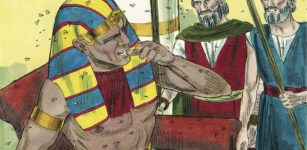 Insects Played An Important Role In The Biblical Exodus
Biblical Mysteries | Jan 13, 2018
Insects Played An Important Role In The Biblical Exodus
Biblical Mysteries | Jan 13, 2018 -
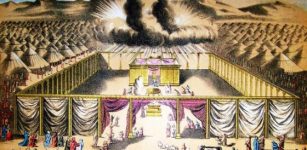 Intriguing Discovery Could Offer Proof Of The Tabernacle – Has The Dwelling Place Of God Been Located?
Archaeology | Nov 9, 2013
Intriguing Discovery Could Offer Proof Of The Tabernacle – Has The Dwelling Place Of God Been Located?
Archaeology | Nov 9, 2013 -
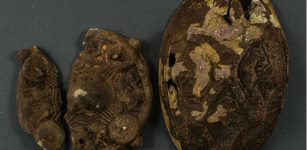 Family Looking For Lost Gold Ring Finds Viking Age Artifacts In Their Garden On The Island Of Jomfruland
Archaeology | Sep 30, 2023
Family Looking For Lost Gold Ring Finds Viking Age Artifacts In Their Garden On The Island Of Jomfruland
Archaeology | Sep 30, 2023 -
 Two Inca Measurement Systems Calculated By Polish Architect
Archaeology | Nov 4, 2020
Two Inca Measurement Systems Calculated By Polish Architect
Archaeology | Nov 4, 2020 -
 The Ruins Of Pennard Castle And The Tale Of Faeries’ Curse
Featured Stories | Mar 2, 2016
The Ruins Of Pennard Castle And The Tale Of Faeries’ Curse
Featured Stories | Mar 2, 2016 -
 Siege Of Masada – The Last Stand Against The Roman Empire
Civilizations | Mar 27, 2017
Siege Of Masada – The Last Stand Against The Roman Empire
Civilizations | Mar 27, 2017
